#rationing
Text

Gasoline rationing during wartime meant that one-third of New York’s 11,700 taxicabs ceased operations on September 21, 1942, under an order of the Office of Defense Transportation. They were stored in a parking lot with their tires removed and their bodies covered with protective grease.
Photo: Associated Press
#vintage New York#1940s#World War II#home front#gas rationing#rationing#wartime rationing#taxis#September 21#21 September#21 Sept.#Sept. 21
155 notes
·
View notes
Text

Remember “Mayonnaise is Cookin’ These Days"? I'm sorry to hear that.
Who ever packed the grocery bag should be fired.
1943
42 notes
·
View notes
Link
While seen as painful belt-tightening, rationing has historically had something of an equalizing effect. During World War II, goods like sugar and butter were rationed alongside the gas and rubber used in the production of arms and other wartime necessities. Rationing those items outside of the market via a government program—giving everyone a fair share—meant richer households might consume less while poorer ones could consume more. Amid rationing during the Second World War II, malnutrition in the U.K. went down. In the U.S., meat consumption actually increased by 10 percent.
[...]
Rationing might come in handy for another, happier aspect of decarbonization. As economist J.W. Mason explains, rationing in the U.S. during World War II was less a response to the war using up essential commodities than to the way war mobilization created a booming job market, boosting demand for those commodities. “Civilian consumption might have been 5 percent higher in 1944 than in 1940; but aggregate civilian wages and salaries were 170 percent higher,” he writes, referencing research by economist Hugh Rockoff. “Prices rose somewhat during the war years; but without price controls and rationing inflation would undoubtedly have been much higher.” Carried out fully, the kind of economy-wide green mobilization that climate-conscious governments have promised may entail similar dynamics, enlisting millions of workers to retrofit buildings and mount transmission lines.
As Wood, Lawler, and Freear note, price controls are an essential complement to rationing so as to “keep key resources affordable for the majority of people, including the poor.” Traditionally rationing systems have meant goods are bought with both ration cards and cash, creating a dual currency system. Price controls help insulate the remaining money economy from the haywire laws of supply and demand. Together, rationing and price controls, the authors explain, “give you an option you simply will not have under other policies: the option to buy goods at a price which is not determined by the market, and which is significantly cheaper than it would be if left to the market.”
[...]
In lieu of today’s hyper-individualized forms of energy consumption, Wood, noted, “you can have a city with inclusive mass transit and good building codes that build places that are cheap for people to live in and well insulated. The idea that current energy consumption is the best way to meet our wellbeing is absurd.” But likewise, he added, “It’s a misconception that the goal to reduce energy consumption and resource use requires us to lower our standard of living.” It might just mean living differently.
67 notes
·
View notes
Text

World War II era U.S. ration stamps.
#vintage illustration#life during wartime#rationing#ration stamps#wwii#wwii era#wwii history#ww2#the 40s#1943#food rationing
12 notes
·
View notes
Text
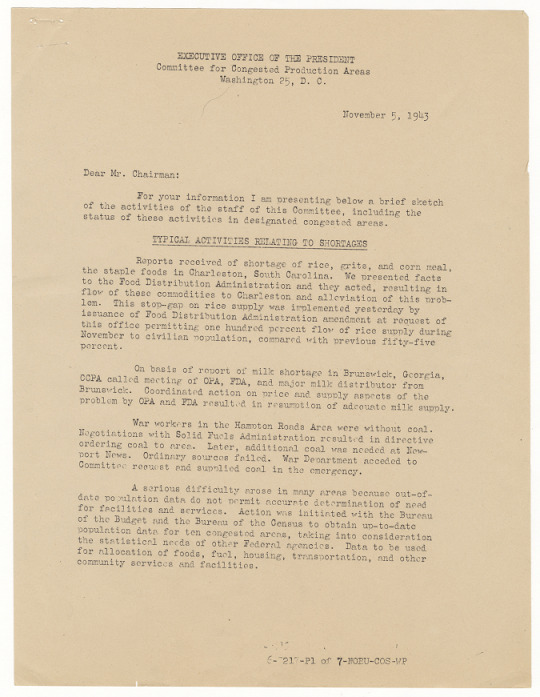



Report from Corrington Gill, Director, to Harold D. Smith, Chairman, Committee for Congested Production Areas, Summarizing the Committee Staff Activities and Resolution of Shortages Found in the Investigation
Record Group 212: Records of the Committee for Congested Production Areas Series: Letters to the Chairman File Unit: Letter to the Chairman - Nov. 5, 1943
This document reports on wartime shortages in milk, ice, coal, etc. around the country.
EXECUTIVE OFFICE OF THE PRESIDENT Committee for Congested Production Areas Washington 25, D.C. November 5, 1943 Dear Mr. Chairman: For your information I am presenting below a brief sketch of the activities of the staff of this Committee, including the status of these activities in designated congested areas. [underline] TYPICAL ACTIVITES RELATING TO SHORTAGES Reports received of shortage of rice, grits, and corn meal, the staple foods in Charleston, South Carolina. We presented facts to the Food Distribution Administration and they acted, resulting in flow of these commodities to Charleston and alleviated of this problem. This stop-gap on rice supply was implemented yesterday by issuance of Food Distribution Administration amendment at request of this office permitting one hundred percent flow of rice supply during November to civilian population, compared with previous fifty-five percent. On basis of report of milk shortage in Brunswick, Georgia, CCPA called meeting of OPA and FDA resulted in resumption of adequate milk supply. War workers in the Hampton Roads Area were without coal. Negotiations with Solid Fuels Administration resulted in directive ordering coal to area. Later, additional coal was needed at Newport News. Ordinary sources failed. War Department acceded to Committee request and supplied coal in the emergency. A serious difficulty arose in many areas because out-of date population data do not permit accurate determination of need of the Budget and the Bureau of the Census to obtain up-to-date population data for ten congested areas, taking into consideration for allocation of foods, fuel, housing, transportation, and other community services facilities. 6-217-PL of 7-NOBU-COS-WP [full transcription at link]
18 notes
·
View notes
Text
War time recipe booklet from General Foods 1943

It begins with an illustration of Victorianna and a letter to Uncle Sam from his 'Niece' pledging to do her best to get dinner on the table despite food shortages.

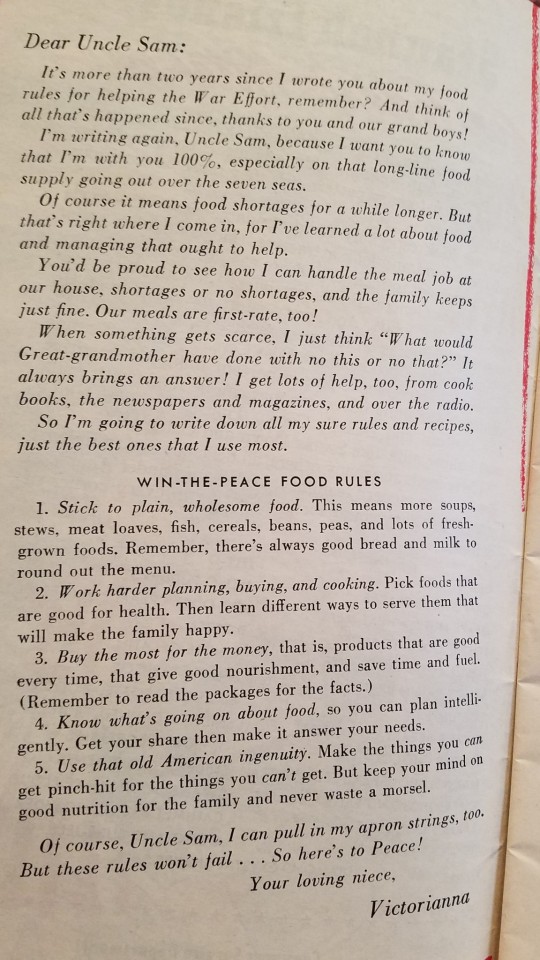
This was a fun read and included many war time tips to make meat, eggs and sugar stretch further.
It suggests adding cereals like grapenuts or bran flakes to tamales, hamburgers, meatloaf, casseroles, breads and pancakes. And, actually the pancakes would be very good with fruity or chocolate cereal.
It also features cake recipes with low or no sugar, subbing all the sugar for honey and or half for log cabin syrup.
The cakes and cookies feature one egg only and have a section on rendering your own chicken fat to sub for shortening.
The lunches and dinners encourage using less meat to really stretch those war time rations.
Another tip is mixing butter for sandwiches with gelatine to make it last longer, but concedes it is not meant to be cooked with.
Here are two featured recipes, one stretching a small amount of sausage with Grape-Nuts and the other a Jell-O dessert featuring postum.
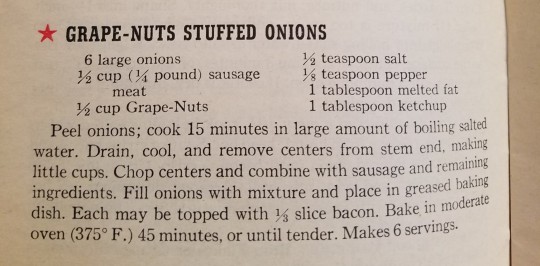

I had not yet heard of postum and was grateful for the following passage explaining its usage. You can apparently still purchase this.

All in all a great little booklet and a fascinating glimpse into recipes and rationing during WW2.
#ww2#1940s#1943#vintage recipes#recipes#rationing#food shortages#history#postum#grape-nuts#stuffed onions#Victorianna
62 notes
·
View notes
Text
Clothing coupons which looked such an imposing array when issued melted to nothing before the onslaught of a coat and skirt, or a winter overcoat. A new kind of gold-digging was evolved by women of all ages, who took up the attitude that their husbands, sons, brothers and men friends would never need any new clothes and so might as well let them have their coupons.
This passage was written by Angela Thirkell in her novel Marling Hall set in the countryside of England which came out 1942 in the midst of World War II. In order to prevent the price of goods from skyrocketing, the British instituted a rationing system whereby people got an assortment of coupons that would allow them to legally buy clothing. Thirkell saw the humor in the scramble to keep well-dressed and within the law. Gold-digger is an insult usually directed at younger women who cultivate older men with money in order to share some of their gold via marriage or other means. Here, Thirkell made every woman into a gold-digger, or at least a coupon- digger.
Clothing for public wearing was more formal, more detailed, and as a result more expensive than what we wear now, so the value of coupons to women was far more than it would be today. True, men's fashions evolved very slowly, but the fabric wore out just the same.
You can find Thirkell's novels at Virago Books: https://www.virago.co.uk/?s=thirkell
#costumehistory#dresshistory#fashionhistory#1940sfashions#fashioninfiction#angelathirkell#marlinghall#viragobooks#rationing#clothingrationing#clothingcoupons
15 notes
·
View notes
Text


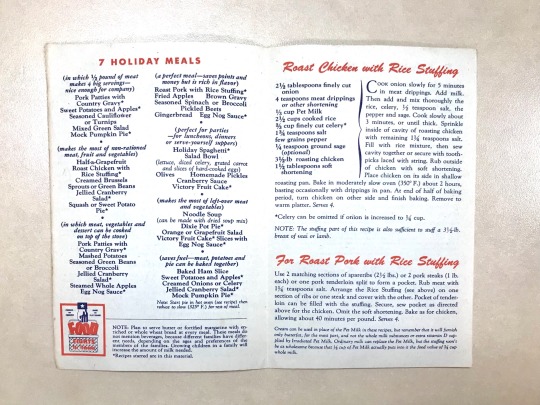


Holiday Meals for Wartime, undated (c. 1941-45)
I love WWII-era recipes. Through a combination of wartime rationing and copious propaganda that advertised thriftiness as patriotic, we got some fascinating recipes.
During rationing, households would receive booklets of stamps on a monthly basis. Each stamp was worth a set amount of ration points. Certain goods, like sugar and fresh milk, were limited on how much you could buy at once. With others, such as meat or specialty goods, you had to spend more points to get the more desirable options. Backyard or community “victory gardens” grew vegetables to help stretch those ration books a little further.
As a result, we see more use of fresh vegetables, thrifty cuts of meat, vegetarian protein sources, sugar substitutes like maple syrup and honey, and canned alternatives to fresh milk products - such as Pet Evaporated Milk, the publishers of this handy little pamphlet.
Here we see homegrown carrots used in place of expensive canned pumpkin; spaghetti made with cheaper bacon instead of fresh ground meat; and ground pork bulked up with rice to stretch those precious points a little further. In-text tips advise using meat drippings in place of shortening or reusing the water you used to boil vegetables, to reinforce that thrifty mindset. A red, white and blue stamp in the corner reminds us - “Food Fights For Freedom!”
This is just such a cool little keepsake. It tells a war story in a way I don’t often see these days. Hope you find it as interesting as I do 💕
(Alt text is provided on all pictures. I am new to this so please let me know whether they are helpful or if you have any suggestions on how I could improve them. Thanks for reading!)
#vintage ads#vintage advertising#vintage recipes#world war two#wwii era#rationing#world war 2#world war ii
6 notes
·
View notes
Text

Postcard with “Special Shoe Stamp” rationing coupon “good for one pair of shoes” stapled to it. 1940s. From our online catalog.
#1940s#world war 2#wwii#rationing#war#shoes#coupon#postcard#history#california#california history#hollywood
16 notes
·
View notes
Text


Between rationing and bombing, food was scarce in wartime Britain
#The Blitz#World War II#London#Battle of Britain#rationing#Red Cross#bombing#hunger#food shortages#1940-1945
24 notes
·
View notes
Text
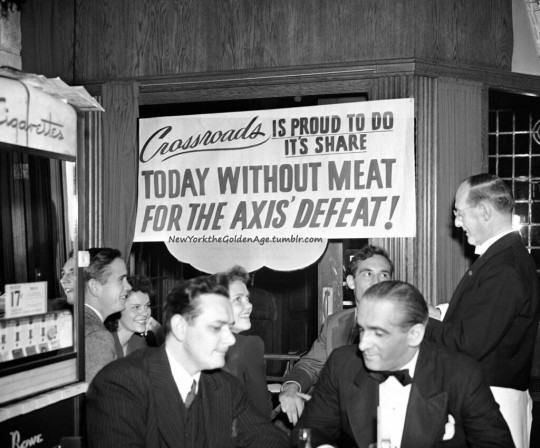
Meatless Fridays: a waiter explains to patrons of a restaurant about the first "meatless" day observed here in 24 years, October 9, 1942. Only fish and vegetable plates were on the menu, designed to help cut the consumption of meat by 21 per cent as requested by the government in order to make rationing unnecessary. It didn't work. Meat was rationed in January 1943.
FN: Apparently, people were no better with apostrophes during the Golden Age than they are today.
Photo: Associated Press
#vintage New York#1940s#World War II#rationing#wartime rationing#meat rationing#meatless meals#home front#October 9#9 October#9 Oct.#Oct. 9#vintage NYC
103 notes
·
View notes
Text

This was from a time shoes were rationed, you could buy only three pairs a year per person. If you had growing children you could have problems, pediatricians and podiatrists complained publicly that shoe rationing would produce a generation of “foot cripples.”
BTW you could buy specific Girl Scout shoes?
BTW #2 The Foot Cripples was the name of a band I had in high school.
Parents Magazine - November 1944
#1944#wwii#rationing#1940s fashion#shoes#children's shoes#vintage ads#vintage ad#advertising#advertisement#1940s#1940s ad#1940's#1940's ad#funny#humor#humour
7 notes
·
View notes
Photo

“Bacon drippings, lard, chicken fat, tallow, when not too strong, may be clarified and used for gingerbread, spice cakes, cookies, and other foods having a strong flavor.”
– How to Live on a Reduced War Budget by Ethel X. Pastor, 1942
12 notes
·
View notes
Text
been drinkingthe same can on monster since like 10am this morning and its 5pm now
2 notes
·
View notes
Text


“In order to ration soap in a manner to cause the least inconvenience to the public and obtain the most satisfactory results, believe the program should be divided between toilet and laundry soaps . . . “ April 28, 1943.
Record Group 188: Records of the Office of Price Administration
Series: Records Relating to the Soap Rationing Program
File Unit: F. W. Woolworth Co.
Transcription:
MEMORANDUM April 28, 1943.
TO: William A. Nielander
Assistant Director
Food Rationing Division
FROM: A.Q.Smith
New York, N.Y.
SUBJECT: Soap Rationing Plans
In reply to your memorandum of April 17, 1943, we
give herewith our views:-
In order to ration soap in a manner to cause the
least inconvenience to the public and obtain the most satis-
factory results, believe the program should be divided
between toilet and laundry soaps for the reasons set forth
herewith.
The greater majority of variety chain and drug stores,
whether chain or not, handle toilet soaps in a considerable
variety but do not handle laundry soaps or powders.
The greater majority of grocery stores handle laundry
soaps and powders, but none, or a limited supply of toilet
soaps.
Department stores usually carry toilet soaps in or
near their drug departments and laundry soaps and powders in
their houseware departments which are often on separate floors,
and it would be inconvenient for a customer to obtain both
kinds of soap on one coupon at one time.
The super-markets carry extensive lines of laundry
soaps and powders, and extensive lines of the most widely used
toilet soaps.
Unless provision were made for obtaining toilet and
laundry soaps separately, the greater part of the business
would tend to flow to the super-market stores.
Further believe that medicinal soap should not be
rationed as it may happen that coupons for a period are used
up, and if a member of the family should become ill and a
medicinal soap is required, there would be difficulty in
obtaining same.
Also believe shaving soaps should be dropped from the
program as such soaps are usually purchased by men, and if the
coupon for a period should be used up, no shaving soap could
be obtained. Grocery stores and super-markets do not carry
shaving soaps and a consumer purchasing soap in such stores
would not be able to obtain shaving soap.
Considering the four systems so far under consideration
believe:
1: The UNIT system may be eliminated as it does not
tend to be sufficiently flexible for this type of rationing.
[stamped at top right]
Apr 29 RECD
FOOD RATIONING DIVISION
[page 2]
Page 2 April 28, 1943.
2: The VALUE system would be the simplest and most
easy to administer and would cover the greatest number and
range of items. However, it would practically eliminate the
higher priced soaps, but as these higher priced soaps are a
luxury, their elimination will be no hardship except to the
manufacturers and the retailers who handle same, or consumers
used to such soaps.
3: The POINT system operated by assigning a number
of points to a coupon and arbitrarily placing a break-point
on a coupon could be operated in a simple manner. For example,
the coupon value of X points would be good for X ounces of
toilet or laundry soaps and one coupon could be used each week.
This would not limit the size or value of the cake of soap,
but would bring up the question of weight. It is believed that
each store could list the factory weight of the soap on hand
until such time as manufacturers could mark their soap with
factory weights. Such factory weights should be placed on
packages or bars of soap or packages of soap powders at the
earliest opportunity. This system would eliminate the objections
mentioned in the first five paragraphs of this letter.
4: The BLOCK system would be inconvenient in that
it would be necessary for the consumer to anticipate her wants
for a set period of time ahead, unless she had a stock on hand
at the time of rationing. If the consumer did not accurately
gauge her requirements, it would mean that she might be short
in one item and over in another, which would be an unsatis-
factory situation. If, however, it is intended to permit the
consumer to accumulate a supply prior to the beginning of the
rationing period, and then use the BLOCK system to replenish
the supply used, the system would be recommended. This system,
however, would tend to draw practically all of the business into
super-market stores as customers would have to purchase all of
their supplies at one point where the various kinds of soaps or
powders were available.
After considering the various systems, we believe
system No. 3., or the so-called POINT system would be preferable
as far as variety chain stores are concerned.
21 notes
·
View notes
Text
@kirsteninthesun Hello I’ve not been very well lately hence the late reply . I don’t know anything about 1940s school uniforms but i found some information on 1940s school uniforms , clothing and rationing. I hope this helps.
youtube
16 notes
·
View notes